Duval History
DuVal Family Overview
Much of the material below is taken from “The DuVals of Kentucky from Virginia and Allied Families” by Margaret Gwinn Buchanan published in 1938, which focuses on descendants of Daniel DuVal’s fourth son, Samuel. Another publication, “The DuVals of Virginia” by Bessie Berry Grabowski published in 1931, focuses on all four sons. A third book, “Civilizers: The DuVals of Texas” by Roy L. Swift, also focuses on descendants of Samuel DuVal. Additional material is from the history of Ware Parish Church. See the research page for more information on these and other DuVal history books.
Daniel DuVal came to Gloucester County, Virginia, March 5, 1701 on the ship “Nassau,” Captain Tragian commanding, having sailed from Blackwall in London on December 8, 1700. He seems to have settled in Ware Parish, and there still is standing the beautiful old church of Ware Parish, established 1650.
In the first days of this parish, almost 350 years ago, people gathered not here, but on Ware Neck. In 1680, while Rev. James Clack was Rector, the Colonial Court and Council in Williamsburg granted permission to construct a new church on the higher ground of the present site. The building was completed between 1690 and 1713. The early church records recording such information were lost during the War Between the States in the burning of Richmond.
The solid brick rectangular building, laid in Flemish bond, was built by local craftsmen and artisans from England. It is the only rectangular colonial church in Virginia with both North and South doors. The classic pediment doors are the earliest of their kind. The walls of the church are three feet thick and the foundations five feet thick. The whole structure is imposing yet elegant in its simplicity. Its architecture is based on the use of squares, golden rectangles, a pyramid triangle and a circle.
No doubt that the loyal Protestant Daniel DuVal was a member of this church. Too much reverence on the part of us who are his descendants cannot be paid to the memory of this Huguenot gentleman, an honored Chevalier de France, a title equivalent to the present one of Knight in England. The earliest of the name that can be traced in Normandy France is one Richard DuVal, 1260, Sieur de France, a title of respect. The spelling of the name as used by the sons and grandsons of Daniel DuVal is with a capital V and only one L.
There was an emigrant from Alsace-Lorraine by the name of Mareen Duvall who settled in Maryland, but no proof of any relationship between the two families has ever been established, although many descendants of both have sometimes thought they were of the same origin. Mareen Duvall, from brewsters or winesters in Alsace-Lorraine came to Maryland in 1659, and is the progenitor of the Maryland Duvals but no kin whatever to the Virginia Huguenot, Daniel DuVal from Normandy. Daniel DuVal had four sons and one daughter, viz:
1. William DuVal of Gloucester Co., Va., Petsworth Parrish; d. 1784
2. Daniel DuVal II, Caroline Co., Va.; d. 1777
3. Benjamin, first Caroline Co., Va., then Henrico Co., Va.; d 1770
4. Samuel DuVal b. 1714, lived in King William Co. then in Henrico Co., Va.; d. 1784, at “Mt.Comfort”, his plantation home in of over 400 acres, now a part of Chestnut Hill and Highland Park in the present city of Richmond, Henrico Co., Va.
5. Mary DuVal b. in Gloucester Co., Va.; m. Mr. Amos in Surrey Co., Va.
Daniel DuVal soon became established as an architect and joiner in which prolific profession his son Samuel seemed to have joined him. The Huguenots, no matter how noble their blood in France, were not afraid to work. Their industry and energy soon gave them high rank in their adopted lands. They were good investors, good business men and had a rare foresight. In the early history of Kentucky, real estate developments, no less than 100,000 acres of land, passed through their hands either as exchange investments or homesteads. This we learn from recorded statistics on file in the office of the Clerk of the Civil Court of Appeals in Frankfort, KY and listed in a wonderful way in the book “Old Kentucky Land Grants. and Entries and Deeds,” by Jillson. These have been copied and are now in the possession of the writer, and but for space and cost, they would be included in these records.
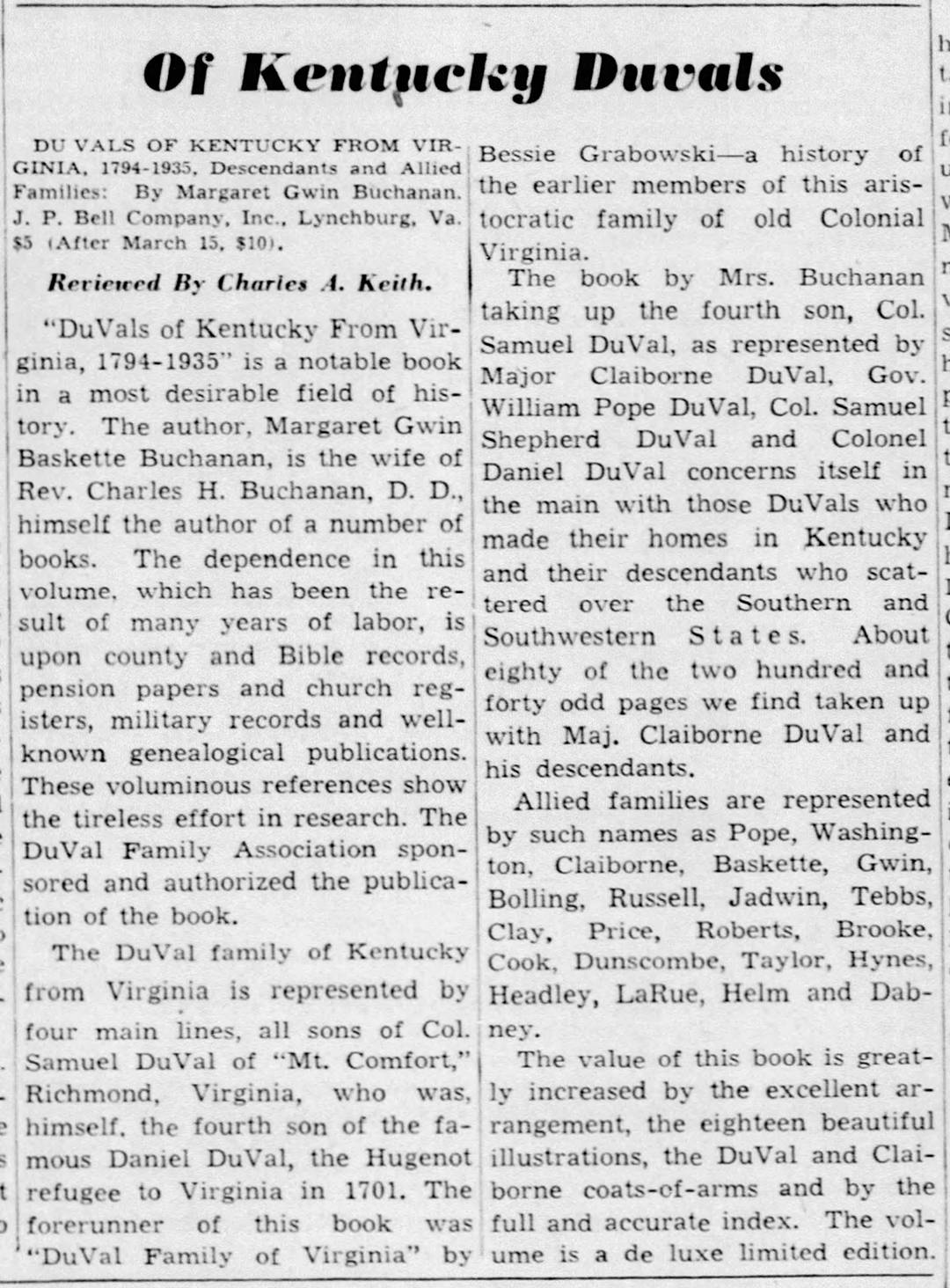
DuVals of Kentucky from Virginia, Book Review by Charles A. Kieth
in The [Louisville, Ky.] Courier-Journal, March 6, 1938.
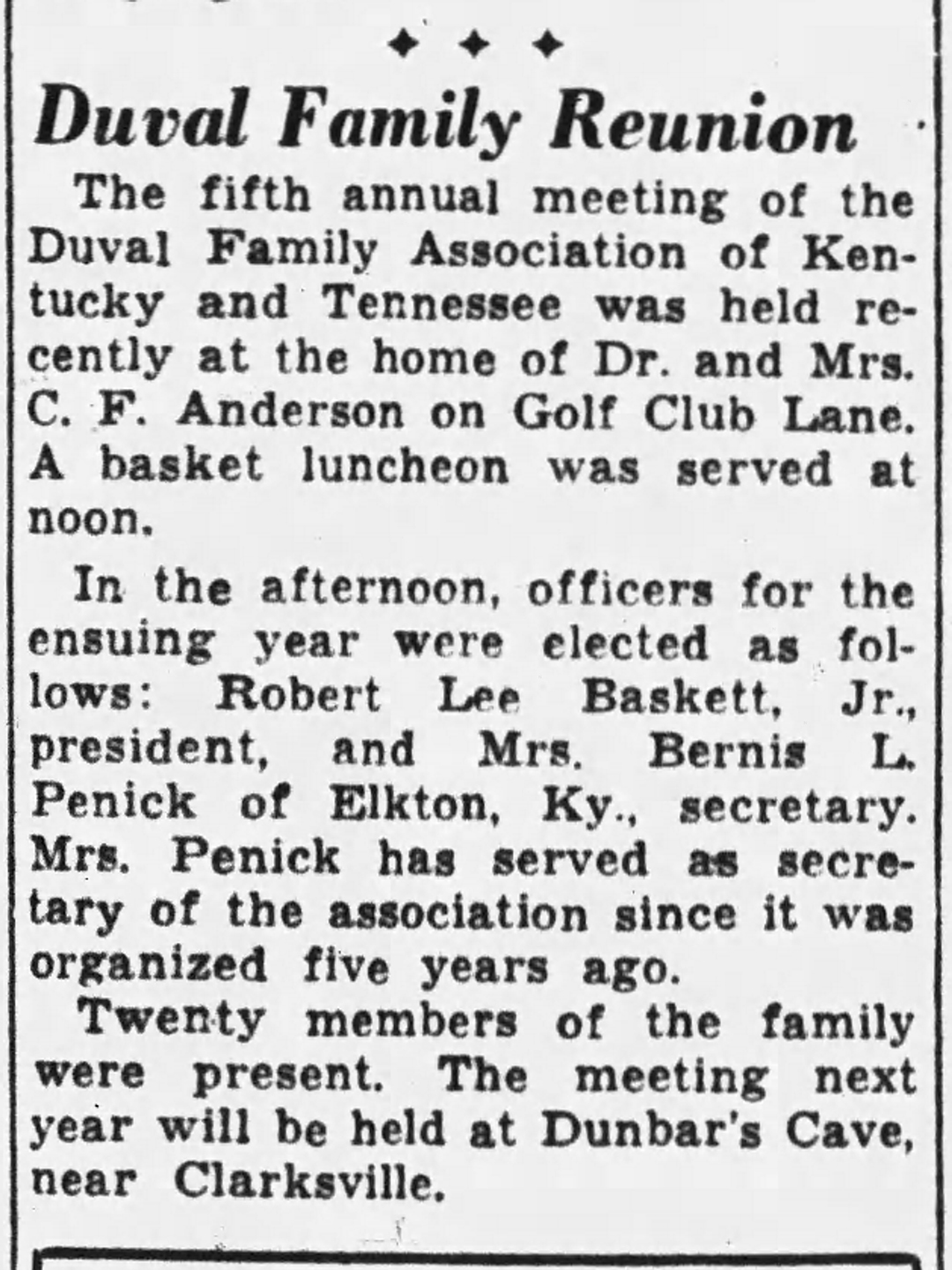
Fifth DuVal Family Association Reunion in
The [Nashville] Tennessean, Sept. 7, 1940.
Check out these pages on our DuVal History!
Pre-Civil War Doll which belonged to Matilda DuVal
The doll shown below belonged to MATILDA DUVAL BASKETTE (1834-1924) daughter of Alexander De La Plaunche DuVal and Margaret Gwin. She lived at Woodlawn Plantation in Mississippi. During the Civil War, just before the Battle of Vicksburg, the beloved home was sacked and pillaged by the invading armies of the North, and suffered the fate of so many of the old southern homes, either burned to ashes, leaving only lone chimneys as mute reminders of the cruel devastation of war; or else passed into alien hands who owned them as mere cotton growing, money – making investments ( p.45, The DuVals of Kentucky from Virginia ).
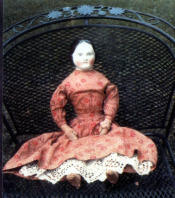
Corrected Genealogy of Samuel DuVal, Jr.
Errors in the DuVal genealogy were discovered in the 1980’s by the DuVal Family Association genealogist, Joseph Stephen Hays of Smith’s Grove, Kentucky. After extensive research, additional information was discovered by Lt. Col. Jack Thacker. Col. Thacker wrote an article entitled “Correcting the Genealogy of Samuel DuVal, Jr.” which was published in The Longhunter, Vol. XI, No 2 in 1988. This correction also appears in “The Descendents of Col. William Claiborne – the 1st Eight Generations.” Compiled by John Frederick Dorman Certified Genealogist, FASG, in collaboration with Claiborne T. Smith, Jr.,M.D. published in 1995.
This corrected genealogy has been recognized by the National Society Daughters of the American Revolution, the National Society Sons of the American Revolution, the Jamestown Society and the Huguenot Society. MANY thanks to Jack Thacker for bringing this information to our attention and to DFA Genealogist Joseph Stephen Hays for providing the information below.
• Daniel DuVal
• Samuel DuVal – Lucie Claiborne
• (1714-1784)
• Samuel DuVal, Jr. * – Margaret Sheppard
• (1751-1825)
a a) Lucie Claiborne DuVal
b) Samuel Sheppard DuVal
* Margaret Buchanan incorrectly lists Samuel DuVal Jr. as Samuel Shepherd DuVal and his wife as Margaret Binns daughter of Christopher Binns.
• Samuel Shepherd DuVal – Anne Everard Bolling **
• (1775-1800)
• a) Samuel Shepherd DuVal, Jr.
b) Archibald Bolling DuVal
**Anne Everard Bolling was a direct descendant of Pocahontas
• Samuel Shepherd DuVal, Jr. – Catherine Eliza DuVal
• (1798-1867)
a) Nicholas DuVal b.cir 1823
b) John DuVal b. cir 1826
c) American DuVal b. 1827
d) Archibald DuVal b. cir 1828
e) Caroline DuVal b. cir 1834
f) Alexander DuVal b. cir
g) Ann A. DuVal b. cir 1838
h) Lucy J. DuVal b. cir 1842
i) Virginia DuVal b. cir 1846
Letter from Pearl Buchanan to Elizabeth Baskette
The following letter was written by the late Pearl Buchanan, daughter of Margaret Gwin Buchanan, and was sent to Mrs. Buchanan’s niece, Elizabeth Baskette along with the French perfume bottle brought to Virginia in 1701 by Philadelphia DuBois DuVal.
Richmond, KY
July 7, 1966
Dear Elizabeth,
I have just sent you a package by insured parcel post which should reach you early next week. A small package is inside the large one because I wanted to be sure that the contents of the small package arrived safely. This is one of my most treasured possessions: Philadelphia DuBois’ French perfume bottle. You will find the story of Philadelphia DuBois on pages 1, 5 and 63 of Mother’s book.
The neck of the perfume bottle had a small v-shaped piece broken out of it not much larger than this: v. I was afraid that the bottle might become further damaged, so I went to the Metropolitan Art Museum when I was in New York one winter and asked what I should do about it. I was advised to have a silver collar made to go entirely around the neck and extend below the chipped place both inside and outside the bottle. That is why there’s a silver covering around the bottle. Originally the bottle was entirely blue.
For twenty-three years this was the pride and joy of my Mother and for twenty years it has been mine. Now I want you to have it for I believe you will appreciate the little heirloom and treasurer it and see that it passes into good hands should it ever go out of yours. Once, I thought of taking it to Williamsburg, Virginia, and giving it to the curator to be placed in some of the Restoration homes but I decided that you ought to have it. I believe it will be happy with you.
Let me know whether the package arrives safely.
With much love,
Pearl
LOST - One Gold Tureen
Family tradition relates that descending within the family was a gold soup tureen that was brought here from the old country. It has been suggested that it was a wedding gift to our immigrant ancestors. Unlike many family traditions, this tureen appears to be real. It has been written about in three distinct sources:
1) Described in the Horsley-Easley Bible (cir. 1840-1880):
Maj. Wm. DuVal’s daughter, Mrs. Adams, saw a family relic, a gold tureen which had the Arms of the DuBois & DuVals intertwined. A lily surrounded by thorns and the motto ‘Lillia inter pinas’. Many reliable and prominent men have seen the tureen heirloom of the DuVals which descended to Samuel DuVal, then to his oldest son, Maj. Wm D., then to his daughter. On the outside was engraved the blooded Arms of DuBois and DuVal. It was handed down to the oldest child, Mrs. Price, and now in Philadelphia, Pa.
2) Bessie Grabowskii included in her book a description of it by Dr. William P. Palmer (cir. 1850) of Richmond, Va.:
It had surmounting the top a tuft of lilies and thorns, with the motto lilia inter Pinas, and also bore the coat of arms. It was kept in a red morocco case with a red velvet lining.” He remembered it being shown to him when as a boy he went with his mother to visit a Mrs. DuVal in Richmond, Virgina. When last heard of it was in the possession of one James Price, a lawyer, who went to Ohio to live, and who was a great grandson of Maj. William DuVal of Richmond, but all trace of it has now been lost.
3) From Nellie Howard Gillian we have an excerpt of a letter with a description:
I, too, have heard about the gold tureen often. It was last heard of in Austin, Texas, having descended to William Price, son of Cousin Marcia DuVal Price. William married a northern woman… After cousin William Price’s death she sold all of the family silver and the tureen by private sale, and returned to her home in the north. None of the family knew of the sale and have never known who bought the silver and the tureen.
This account by Mrs. Gillean seems to be the most accurate. The northern woman was Achsah Catherine “Kate” Starr. After the death of William Price she married Otto H. Woehsner a hatter in Austin, Texas where they were living in 1880. They later moved to Cleveland, Ohio. The question is did it go to Cleveland, Ohio or remain in Austin, Texas?
Discussion: The soup tureen would have been the size and shape of what we now know as a large covered vegetable dish with legs. Described as a gold tureen it could have been a solid silver item that was gilded (washed with gold). Having its own velvet lined, leather covered case attests to its worth, even when it was new. Soup tureens are a distinctively French innovation appearing in the 1690’s which is in keeping with both our French family heritage and the approximate marriage date of Daniel Duval. Although recorded that engraved upon the tureen was our quartered coat-of-arms with the motto: Lillia inter pinas it is more correctly: Lilium Inter Spinas meaning “Lily Among Thorns” and has its origins in Solomon’s Song of Songs. This motto and subsequent various crests have a very ancient and varied history. The French fleur-de-lis or “flower of the Lily” is synonymous with the Lily in the motto.
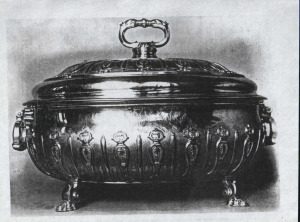
The tureen may have looked similar to the one above. This example from London, England is of Huguenot origin. If anyone has ANY idea where the descendants of Daniel DuVal might search for this item please e-mail: Joseph Stephen Hays
Information on the ship "Nassau" & Passenger List
Information regarding the ship “Nassau”
The information below was submitted by Thomas Langford.
The following is a common statement by the Admiralty for permits issued at that time:PRO Class Adm. 1/5148: 18 January 1701/2 Permit for the “Nassau” to proceed notwithstanding the embargo.PRO Class T. 70/43: 6 February 1701 Letter sent via (possibly) the “Nassau”, Capt. Tregian, bound for Virginia.PRO Class P.C. 2/78 (Privy Council): 18 January 1701/2 The “Nassau” received permission to depart Kensington for Virginia with 150 passengers. (P. 307)At least this provides the ship’s master, Capt. Tregian, a count (likely approximate) of passengers, and an approximate date of sailing (6 Feb.). Here is the source which may contain a list of the passengers:”Documents, Chiefly Unpublished, Relating to the Huguenot Emigration to Virginia and to the Settlement at Manakin-Town, with an Appendix of Genealogies, ….” by R.A. Brock (Richmond, Virginia Historical Society 1886)247 p. Reissued copy by the Genealogical Publishing Co., Baltimore, 1962.
This book is likely available from a normal genealogical book source.
Tom Langford
Genealogy,
American Plantations and Colonies,
Ships and Passengers
Historical Facts about the DuVals
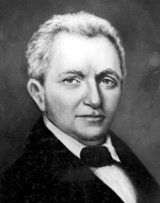
Did you know that on March 25, 1775 George Washington dined at Galt’s Tavern in Richmond, VA but stayed with Samuel DuVal whose home was called Mount Comfort on upper Shockoe Creek, northeast of Richmond? (From Inside Richmond – Annual Guide for Visitors)
Lucie Claiborne DuVal, wife of Samuel DuVal, was the great great grandaughter of William Claiborne who arrived in Virginia in 1621 and who was appointed first Secretary of the Colony of Virginia.
William Pope DuVal (pictured), son of Major William DuVal and Ann Pope, was appointed United States District Judge for the Territory of Florida in 1821, and served as Territorial Governor of Florida from 1822 to 1834.
The Duel which took Nathaniel DuVal's life
NATHANIEL POPE DUVAL was the oldest son of Major Claiborne DuVal and Elizabeth Pope. He was born in Richmond in 1785 and moved to Kentucky when he was nine years old.
He was an extraordinarily handsome and gallant man of that period. As he was passing a corner of a street in Louisville, KY on which was grouped some of the fashionable youth of the city, he heard a loud guffaw of laughter as one of them mentioned the name of his sweetheart. Immediately he slapped the face of the offender with his glove, and a duel resulted, in which he received a mortal wound.
It is said he sat with his back to a tree after he was shot, cooly smoking a cigar, until death ended the life he readily gave in defense of the honor of the name of the lady whom he loved.
His body was buried in the old Jefferson St. Cemetery, and a marble shaft was erected over his grave. No trace of either could be found in the spring of 1933 when diligent search was made for it by Miss Dorothy Laverty and Miss Pearl Buchanan in an effort to locate his grave and secure the date of his death.
The information above is taken from “The DuVals of Kentucky from Virginia” by Margaret Gwin Buchanan.
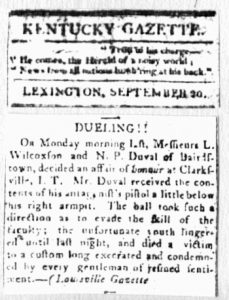
Question of the Month
Miniature Stoneware Jug
Could this S.J. Duval be of our clan? This miniature stoneware jug has an under-glaze bluish gray mark “COMPLIMENTS OF S.J. DUVAL 316 BONHAM ST”. Although it has an address of 316 Bonham St. it does not have a city listed. Several of these have surfaced in Texas and although it could be from any town with a Bonham St. It has been suggested that it is from Fort Worth, Texas. It would date from around 1900 until 1920 and given away as a complimentary sample of, no doubt, liquor. It measures 3 inches high and is 2 inches in diameter at the widest point. There is a brown glaze on the neck and shoulder.
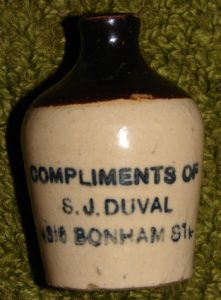
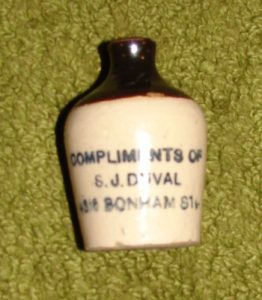
Please e-mail any information to: Joseph Stephen Hays
Ware Episcopal Church
Colonial church in Ware is rare gem
By Mark St. John Erickson
Daily Press
GLOUCESTER — When the well-to-do congregation of Ware Parish began planning a new and much bigger church during the early 1700s, they did so with no small ambition.
What the vestry designed – with the help of a now unknown builder – was destined to become one of Colonial Virginia’s largest houses of worship. It also represented a radical departure from one of the colony’s oldest and most ingrained architectural traditions.
Instead of embracing the Anglican preference for a narrow rectangular plan – and expanding it by adding wings to the sides – they turned to something that was both wider and deeper.
What resulted was a robust, handsomely proportioned brick box unlike almost every other church in the Old Dominion.
At just over 80 feet long, the new building surpassed by several feet the extent of most other Virginia churches. And its majestic 40-foot breadth gave the interior a kind of expansiveness that had seldom been seen before.
“This is one of those rare times when the builders in Virginia dared to span more than 35 feet – and that made Ware one of the largest churches built during the Colonial period,” says architectural historian Carl Lounsbury of Colonial Williamsburg.
“But in terms of its proportions, it’s nothing like other Virginia churches. What you have in Ware is more like the new wave of Anglican churches designed by Christopher Wren in the late 17th century after the Great Fire of London.”
Ware Episcopal Church dates to the early 18th century, possibly as early as 1710, and represents one of Colonial Virginia’s largest rectangular churches. It’s located on Routes 3 and 14 just east of Gloucester Courthouse. Sunday services are held at 8:30 and 10:30 a.m. Visitors may tour the church by appointment. Call (804) 693-3821.
Few of Virginia’s Colonial churches extended beyond an unwritten limit of 70 feet, scholars say, because of problems in hearing the sermon from the rear pews.
But in a handful of cases, including Ware Parish, the builders solved the puzzle of size in much the same manner as Wren and his followers in England. Instead of simply lengthening the structure, they increased its breadth by the same proportion.
Later changes at Ware have altered the original 25-foot height of the ceiling and other interior dimensions. Yet the acoustics are still so good that today’s sermons carry as well as those of 250 years ago.
“Ware gives you a good sense of what was then sometimes called `a preacher’s box,'” Lounsbury says.
“It’s a big, open, boxy church in which you can easily hear just about everything that’s said . It’s less like a traditional Virginia church and more like what we call `a meeting house form.'”
Despite the church’s unconventional plan, it still incorporates many of the hallmark traits of Virginia’s Colonial building tradition.
Raised from massive, nearly 6-foot-wide footings, its strong Flemish-bond walls measure more than 3 feet in width. The carefully laid joints and clever spacing of the irregular hand-made bricks represent one of the finest surviving achievements of 18th-century Virginia’s masons.
Ware Church is nestled in a wooded setting near the Ware River.
Among connoisseurs, in fact, the walls at Ware and nearby Abingdon Church rank among the most pristine to be found in any Colonial structure. “… Ware Church exhibits Flemish bond masonry of the highest elegance and most remarkable preservation,” wrote pioneering architectural historian James Scott Rawlings.
Ware’s other attractions include the original brick pediments and moldings surrounding its trio of doorways. No other rectangular Colonial church has managed to preserve these distinctive architectural features, scholars say.
Inside, the interior of the structure has changed radically since the sanctuary first opened – probably sometime in the early 1720s.
But even these Victorian additions glimmer with a palpable feeling of age.
When the congregation decided to “modernize” Ware during the mid-19th century, workmen removed the original flagstones and Colonial-era box pews, then raised the floor several steps above its original level.
But little has changed since they re-arranged the seating plan and installed a then-contemporary set of bench pews.
“These `new’ pews – as we call them – were put in back in 1854,” the Rev. Daniel O. Worthington Jr. says.
“The last major renovation after that was when we enclosed the gallery to make a Sunday school. We put in electricity at the same time.”
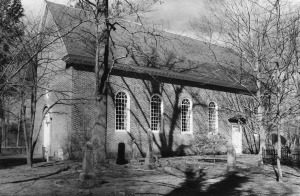
Which DuVal is your ancestor?
Which DuVal is your ancestor?
From which child of Daniel DuVal do you descend?
William?
Daniel?
Benjamin?
Samuel?
Mary?
Have you considered submitting information about your DuVal ancestor? If you are a direct descendant of Daniel DuVal and you have an interesting story to share please e-mail Joseph Stephen Hays.
William DuVal - Petsworth Parish
William DuVal – Petsworth Parish
This information was provided by Mr. Cy Rilee, a descendent of William DuVal.
The source of the information is: “The Vestry Book of Petsworth Parish, Gloucester County, VA 1677-1793” transcribed, annotated and indexed by C. G. Chamberlayne.
18 Oct 1738
To Wm. Duval’s Acco for making steps for the Organ 0066 lbs tobacco
12 Oct 1739
To Wm Duval’s acct for work done to the Church 0160 lbs tobacco.
Ordered that James Baker be collector for this present year & that he receive 35 lb of tobacco & Tith to Discharge the parrish Debts and Mr. William Duval Agrees to be his security for the said Collection 13 Nov 1764
12 Dec 1768
Mr. William Duval is Chosen Vestry man in the room of Mr. Warner Washington who has resigned it.
15 Nov 1771
Mr. William Thornton is Appointed Church Warden in the Room of Mr. William DuVal
3 May 1784
Capt Charles Tomkies is Chosen Vestryman in the Room of Mr. William DuVal who declines.
28 March 1785
We The Subscribers being this day duly Elected Vestrymen for the Parish of Petsworth in Gloucester County do profess ourselves to be Members of the Protestant Episcopal Church:Georg. Booth, Lewis Booker, Robert Yates, M. Anderson, Peter Kemp, Wm. Sears, Richard Taliaferro, Sterling Thornton, James Baytop, Chas. Tomkies,William Duval, Thomas Booth, and Ben Dabney
23 Apr 1785
Mr. Wm. Duvall & Capt Charles Tomkies are Apointed Church wardens for the time being.
14 July 1787
Wm. DuVal & Capt. Lewis Booker are Chosen Churchwardens.
15 Dec 1787
Mr. James Wiatt is Appointed Churchwarden in the room of Mr.Wm. Duvall and to settle with the late Churchwarden for his proceading.
This all on William DuVal except for the mention of his presence at various vestry meetings prior to this last entry on 15 Dec. 1787.
